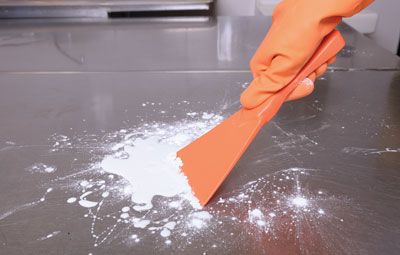Best Practices for Color Coding
Equipment and Processing Report
Pharmaceutical manufacturing facilities can help prevent contamination and cross contamination by using color coding.
The World Health Organization (WHO) defines contamination as “the undesired introduction of impurities of a chemical or microbiological nature, or of foreign matter, into or onto a starting material or intermediate during production, sampling, packaging or repackaging, storage, or transport." WHO defines cross-contamination as "contamination of a starting material, intermediate product, or finished product with another starting material or product during production" (1).
In 2003, WHO released their report on specifications for pharmaceutical preparations recommending that certain hazardous substances be processed and filled in segregated areas (1). FDA requires that, with few exceptions, all drugs be manufactured in compliance with CGMPs. It has become increasingly important for all pharmaceutical facilities to implement documentable precautionary measures for the prevention of both contamination and cross-contamination. Many pharmaceutical companies have implemented color-coding as one of these risk-mitigation methods. The following best practices can help make a color-coding program successful.
Figure 1. Color-coded tools help prevent cross-contamination. Image courtesy of Remco.

Color coding by zones
Manufacturing facilities that produce multiple drugs may already have separate buildings or strict zoning specifications in place. In this case, it is recommended that each zone or building is assigned a color. All tools used in that zone correspond to the assigned color. Best practices dictate that everything from the scoops that collect medicines and medicine ingredients to the cleaning tools, such as brushes and brooms, be color coordinated to ensure that tools stay in proper zones and only come in contact with the correct materials (see Figures 1 and 2).
Figure 2. Color-coded scoop. Image courtesy of Remco.

Color coding by potential hazard
Many pharmaceutical manufacturing facilities choose to color code by identifying potentially hazardous drugs and materials. Color coding is most successful when done as simply as possible. For example, if a facility identifies only one material that falls into this potentially hazardous category, it should have a two-color plan: one color for tools that come into contact with the hazardous material and one color for all other tools. If several potentially hazardous materials are identified, a few different colors could be used. If you are at the point where you can no longer easily remember the color meaning, however, you should probably reconsider your color-coding plan and aim for something simpler.
Planning
When building out a color-coding plan, it is important to have everyone involved in the manufacturing process voice their opinions. Everyone, from the pharmaceutical experts to the people who are responsible for cleaning the facility, should be involved in the process and should propose the plan they believe works best. The most successful plans are usually devised this way, because no possible issues are overlooked, saving time and money in the long run.
Long-term evaluation
Frequent re-evaluation is needed to ensure a long lifetime of a color-coding plan. Again, this should come from employees at all levels of the company hierarchy to gain a full picture. It is our experience that addressing problems earlier and often is key to ensuring the plan continues to meet your needs.
Reference
- WHO, “WHO Expert Committee on Specifications for Pharmaceutical Preparations, 37th Report” WHO Technical Report Series 908 (Geneva, Switzerland, 2003).
About the author
Bob Serfas is the founder and executive of R.S. Quality Products, which distributes color-coded tools.
Intertek to Expand UK GMP Facility with 6000 Square Feet of Lab and Office Space
May 7th 2025The company said the expansion is in response to globally rising demand for inhaled biologics, which offer distinct advantages in route of administration, but can be challenging products for developers.
